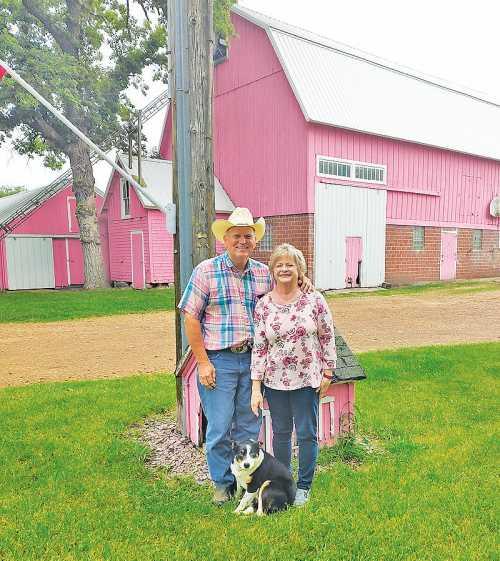
11 minute read
From My Farmhouse Kitchen
A new dog in the family reminds me of others
My son and his wife thought it would be a good idea to purchase a puppy for their daughters. A puppy would grow with the girls, possibly guarding the girls against the rattlesnakes which are prevalent in their area.
Advertisement
They purchased a puppy on a benefit auction. The puppy was born in Texas on Jan. 20. A pickup truck and trailer delivering horses further along the trail stopped with the puppy on May 9.
This Miniature Australian Shepherd has already become part of the family. My granddaughters have been taking him on walks as well as training him not to chase birds.
He has been proving his guard dog instincts. When it gets towards dusk, he gets a little growly at people walking around outside.
On June 12, a storm moved through just after dark. I would call it a tornado, but can’t say that with all certainty; because when the National Weather Service came out to my son’s farm, they themselves couldn’t decide whether it was a tornado or just very strong winds.
Nevertheless, the dog was in his house. The dog house flipped over on its side landing with the door side to the ground. When my son checked on him, the dog was content in the shed, probably thinking it was nighttime. There he stayed until morning as more storms moved throughout the night.
But, when morning came it was a different story. The dog was in an agitated state until he saw the girls safe and sound. He was happy as a lark. He is also displaying his watch dog instincts at dusk. He growls at everyone who comes near the house.
Oh yes, this dog has a name: Duke. The name garnered the most votes from family members.
I was surprised it wasn’t Balto. Balto, is the Siberian husky who became a hero when he was the guide dog on the dog sled mission trip to bring the Dipththeria vaccine to Nome. The dreadful disease Diphtheria — which is often fatal, especially to young children — was ravaging families.
Unfortunately, the closest vaccines were in Anchorage, hundreds of miles away. It was winter. Thankfully the vaccines were moved to a closer town: Nenana, still over 480 miles from Nome according to some reports. The Alaska archives says 674 miles. I haven’t traveled the route so I can’t prove which report is right. But I will agree that winter in Alaska can be brutal with strong winds and very frigid temperatures. When the mercury dips down to -40 F, it is not a trip for the faint of heart.
As the guide dog, Balto was responsible for leading the way. In its beginning years, the Iditarod honored the dogs and men who made this mercy trip in 1925. This story of Balto has been preserved in film, documentaries and books. In fact, it was my granddaughter who introduced me to Balto.
One of the first books she read out loud to me was called Balto.
Doc Neumann was born a year after this famous trip. He and I wrote of some more challenging experiences with dogs in the book, “Get
Up, Get Going” which records some of his experiences as a veterinarian. He also has some interesting stories of notable dogs that remain fresh in this 96-year-old gentleman’s mind.
Doc grew up on a farm just on the outskirts of
Preston, Iowa. He started school when four years old. On his daily walk to school he had to walk by several homes that had dogs. They weren’t vicious dogs at all, but they still frightened him.
When his parents noticed this fear, they decided something had to be done. They felt that the best way to conquer this fear was to get him a dog.
His father studied the advertisements in the newspaper. There he read about some Great Dane puppies for sale in Danbury, a town in western Iowa. He contacted them and a pup was soon purchased.
The Neumann farm was clear across the state on Iowa’s protruding bump near the Mississippi River. A bit far for a road trip in those days for most people. Thankfully, the trusty rail service would provide the transportation.
Finally, the day came when the Neumann family received a telephone call from the Preston Depot. There was some freight that needed to be picked up.
The family walked to the depot to find a recently weaned black and white puppy in an egg crate. Some water and food had been provided for the puppy during his journey across the state in a freight train car.
They named her Doodles. This dog became a constant companion for Arlo and his brother Darryl whether they were just doodling around or working.
They trained the dog to pull a sled. This was especially handy when snowy winters and Preston’s hills provided the perfect combination for sledding. Doodles would not only pull the Neumann sled up the hill, but other children’s sleds were joined together to form a train for the return trip. Then the merriment started all over again.
When the boys went out to hunt squirrels, Doodles was part of their team. She seemed to know when they were ready to go to the timber. She would chase a squirrel up a tree, go to the other side, then one of the boys would get the prey — one at a time — for their supper meal.
Arlo’s mother always insisted that Doodles sleep outside or in the barn. That is until one cold, winter night. Mrs. Neumann had gotten up to warm up milk on the cook stove for the newest baby in the Neumann family when she heard a loud racket outdoors. It startled her. She made sure all the doors were locked.
The next morning, the family saw footprints in the snow. Someone had been peering into the kitchen window. Doodles possibly prevented trouble when she chased the person away. After that, Mrs. Neumann relented, the dog could spend the night in the kitchen near the woodpile on the really cold nights. Iowa also gets cold in the winter. Well, maybe not quite as bad as Alaska. FROM MY Doodles lived with the Neumanns until her death FARMHOUSE during Arlo’s senior year. This Great Dane had his KITCHEN own look, as her ears were never cropped or the tail docked. By Renae B. Vander Schaaf This next story was told to Doc Neumann by a friend who had a relative who fed cattle near Sioux Center. Cattle need to be fed daily. There are always
See FARMHOUSE pg. 5
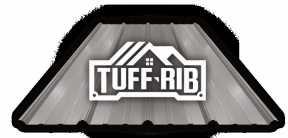
30 COLORS 26-29 GAUGE Standard all round durability

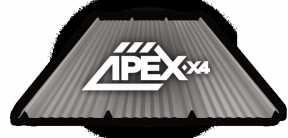
30 COLORS 26-29 GAUGE
Standing seam architecture look for half the price


30 COLORS 26-29 GAUGE
Residential and round roof applications
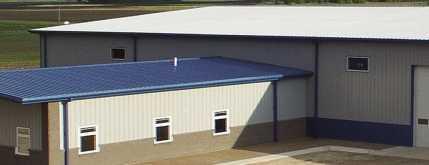
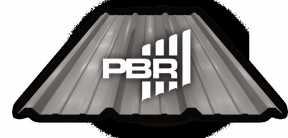
Commercial and wide Perlin applications
By WHITNEY NESSE The Land Correspondent
BROWNTON, Minn. — When driving west of the Twin Cities on U.S. Hwy. 212, one is bound to see pink on the horizon. Not the pink of a beautiful, prairie sunset, but the hot pink barn which stands close to the highway, whose brightness begs to be seen.
The building site is flashy, boasting its bright pink barn and pink trim. However, you will find that the horseman who resides there is neither flashy nor boastful. On the contrary, Keith and Jane Tongen are humble people who have strong faith, a rich heritage and a deep love for horses.
“I am a third generation horse trader. My grandpa was August Olavis; my dad, Curtis Olavis; and I got the Norwegian name of [Keith] Olavis as a tradition. We’ve all three been horse traders,” beamed Keith. “I always tagged along with my dad when he would go out and buy a horse. When I was 12 years old, my dad was in Waverly, Iowa at an auction with some horses. My mom took me to the Twin Cities, I got on a Greyhound bus, rode the bus to Waverly, and bought my first horse. I paid $60 for it and sold it seven days later for $125, so I was off and running!” reminisced Keith. “I skipped my junior prom to go to a horse auction.” Keith did, however, make it to his senior prom with Jane as his date, and the rest is history they chuckled.
As a teenager, Keith recalled his family did a lot of retail trading of riding horses. “We would advertise in the Minneapolis Sunday paper. At that time, you could get an itty bitty ad. It was three lines for $48 dollars. Many weeks we would sell seven or eight riding horses on a Sunday. If we ran an ad, we couldn’t go anywhere. We stayed home and answered the ad!”
Keith noted it was in the early 1980’s when


TELL US HOW YOU REALLY FEEL
and we’ll give you abetter magazine.
Take our survey for a chance to win a $200 Visa Gift Card.
https://www.research.net/r/100337 horse trading picked up. Through various industry contacts, he obtained contracts with the YMCA and Girl Scouts where he would lease each of them horses as well as all of the riding tack during the summer months. “We did that for quite a number of years. It was a win-win situation for [all parties] and it was fruitful for a while.”
During that same time, while their business was expanding, Keith learned about another opportunity within the horse industry. “I got hooked up with a couple of friends of mine that were shipping slaughter horses. At the time, there were a ton of horses around. Horses were overpopulated. We hear all about [horse] rescues now. Well, we were doing that back then. Many of the camp horses that I sent to the Girl Scouts and YMCA were purchased as slaughter horses and they were great!”
Keith highlighted that during the years he was shipping slaughter horses, which was from 1985 to 2020, he maintained excellent relationships with his veterinarians and border control inspectors. “I always tried to treat the horses with respect and dignity. I made sure they were fed and watered properly and loaded properly. As time went on, more and more rules and regulations were implemented — and most of them were good rules. It’s real-
Keith and Jane Tongen in a sea of pink on their farm near Brownton, Minn. ly a political hot potato, the whole horse slaughtering thing, but throughout that whole time I was never ashamed of [my job]. We did it, we tried to do it with dignity. There’s a time to live and a time to die, just like Ecclesiastes says,” said Keith. As business picked up, Keith made more contacts within the horse industry — some of them being folks who worked with pharmaceuticals. “We did quite a bit of business in pharmaceuticals with different veterinary supply [companies]. They want healthy — and even pretty — horses.” Keith said that not only can horse plasma be used in different anti-rejection drugs for human use, it is also useful for harvesting antibodies for veterinary use. He explained that horses purchased for pharmaceutical use are used as production animals which are kept and cared for as long as they have good antibody counts. Once their numbers begin to decrease, that particular horse will be sold and another bought. “There is so much to it. One outfit down by Sioux Falls had a horse that was [producing] for 22 years. I said to the guy, ‘I bet that’s a million dollar horse!’ And he said, ’Oh, no, no, no. That’s a many, many million dollar horse!’”
By the year 2000, Keith was spending much of his time on the road going to horse auctions. “In 2000, I had a 41-day stretch where I slept only five nights at home. I got very tired of road travel,” he said. His travels took him mainly throughout the Midwest and parts of Canada. However, there were times Keith traveled to Pennsylvania, California, Washington and Idaho.
In the 1990’s Keith began exporting draft horses to Japan. “In 2004 I was able to ride along. They would charter a 747 jet and put approximately 90 horses on it. The airplane ride itself was about $4,000 per horse and they didn’t even serve peanuts or coffee or Coke!” laughed Keith. While he was in Japan, Keith and Jane’s daughter was serving in the U.S. military stationed in South Korea, so Keith had the opportunity to
